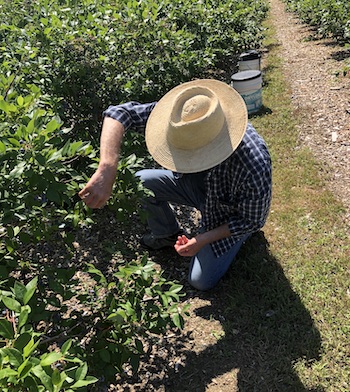Adding up? I’d say that’s true for words and berries.
First, the words, which in my case totals 78,000 for my new novel, Killing the Story, which will be published Aug. 26, a month from when I am writing this blog. The book is No. 4 in my Isabel Long Mystery Series.
In Killing the Story, I started with the first word, in this case, “we,” and then moved onto the rest of the sentence “buried the old chief today.” I kept it going, one word at a time, until the end.
Of course, nobody writes a perfect book in one fell swoop. I certainly haven’t. So, I went back, saw what I was missing, just like today when I was picking berries.
But before I blog about berries, here’s a trailer I created about Killing the Story. Check it out.
Now, about those berries. Today, Hank and I made two harvests: blueberries at a pick-your-own farm near our village and raspberries at our neighbors’ across the street. That’s him in the photo above. (Yes, masks on even there.)
At the farm, we’d choose a row, look for the bushes that had ripened berries and get to work. Sometimes I picked just one blueberry, sometimes a few at a time. And, funny, just like writing, I wasn’t thinking of doing anything else. At the end, we had enough for a pie I baked later, some to freeze, and some to keep for fresh eating.
freeze, and some to keep for fresh eating.
Then, we headed across the street. Our neighbors, who already had their fill of their raspberry crop, invited us to take whatever was left. It was obvious the bulk of the crop was gone, but there was certainly enough for Hank and I to collect a generous amount of berries in our colanders.
Here’s what I noticed this time. I would pick between the overgrown rows, thinking I got all of the ripened berries along the way, but when I turned around, I saw more I had missed on the very same row.
Another perspective for certain, sort of like the editing process.
As I wrote before, my editor, Miriam helped me see the things I missed while writing Killing the Story. Yes, there were typos to fix, but I’m thinking about her questions about the plot and characters.
The same thing happened when my publisher sent me a pdf of the book he had laid out. A different format for sure, and, yes, when I looked, I saw small things for him to change.
So, the fruits of our labor, at least at the pick-your-own-farm, were baked into a pie. I also froze a bunch  and kept some for fresh eating.
and kept some for fresh eating.
And in a month, fans of the Isabel Long Mystery Series will get to see the end result when Killing the Story is published on Amazon. I hope you enjoy reading it as much as I did writing it.
Here’s the link to pre-order: Killing the Story on Amazon

